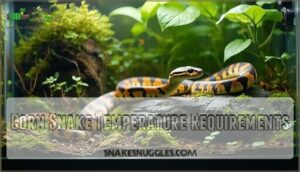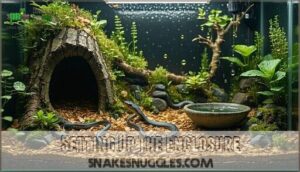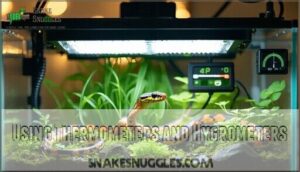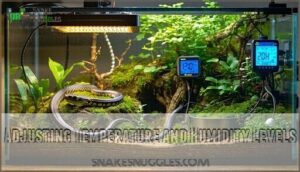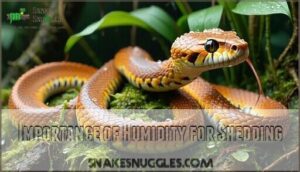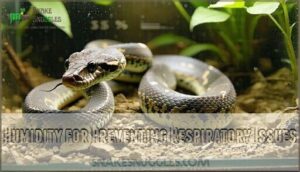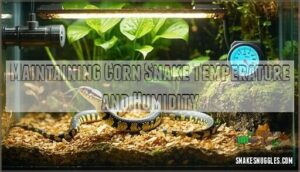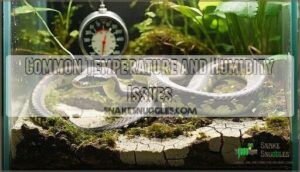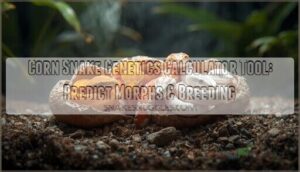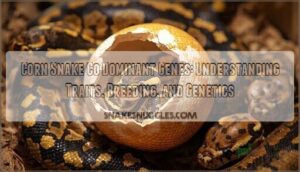This site is supported by our readers. We may earn a commission, at no cost to you, if you purchase through links.
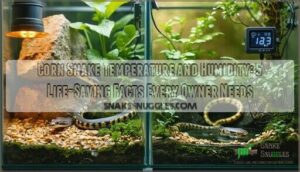 To keep your corn snake thriving, aim for a temperature gradient in their enclosure: 75-82°F on the cool side, 85-88°F in the basking spot, and around 70°F at night.
To keep your corn snake thriving, aim for a temperature gradient in their enclosure: 75-82°F on the cool side, 85-88°F in the basking spot, and around 70°F at night.
Use a heat lamp or mat with a thermostat for precision. Humidity should stay between 40-60%; too low can cause shedding issues, while too high risks respiratory problems.
A hygrometer helps you monitor this. Add a humid hide or mist lightly during shedding. Think of their setup as a mini climate system—balanced and consistent.
Curious about common pitfalls or tools to make this easier? There’s more to explore on perfecting their care!
Table Of Contents
- Key Takeaways
- Corn Snake Temperature Requirements
- Creating a Temperature Gradient
- Corn Snake Humidity Requirements
- Maintaining Corn Snake Temperature and Humidity
- Common Temperature and Humidity Issues
- Frequently Asked Questions (FAQs)
- Is 70% humidity too high for a corn snake?
- Do corn snakes need heat 24/7?
- How much humidity should a corn snake enclosure have?
- Do corn snakes like humidity?
- Do corn snakes need heat?
- Can corn snakes regulate body temperature?
- What temperature should a corn snake enclosure be at night?
- How do you monitor a corn snake’s temperature & humidity?
- What temperature do corn snakes like?
- What is the coldest temperature a corn snake can survive?
- Conclusion
Key Takeaways
- Keep the enclosure’s temperature gradient between 75-82°F on the cool side, 85-90°F in the basking spot, and 68-70°F at night for proper thermoregulation.
- Use digital thermometers and hygrometers to monitor temperature and humidity accurately, and adjust as needed.
- Maintain 40-60% humidity normally, but increase it to 65-75% during shedding to prevent stuck shed and skin issues.
- Always use thermostats with heat sources to avoid overheating and ensure consistent temperature control.
Corn Snake Temperature Requirements
You’ll need to maintain a precise temperature gradient in your corn snake’s enclosure, with a basking area of 90°F and a cool side between 75-82°F.
This temperature range directly impacts your snake’s digestion, metabolism, and overall health, making proper heating essential for their survival.
Temperature Gradient Requirements
Creating an effective temperature gradient is essential for your corn snake’s thermoregulation. This natural temperature variation mimics their wild habitat and directly impacts their health and behavior.
An ideal temperature gradient supports your corn snake’s health, mimicking their natural habitat for proper thermoregulation and overall well-being.
- Temperature ranges should span from 75°F (cool side) to 90°F (warm side)
- Gradients allow snakes to self-regulate their body temperature
- Poor temperature control can lead to digestive issues and illness
- Monitor multiple points in the enclosure daily
- Proper thermoregulation supports normal activity levels and feeding response
Basking Surface Temperature
Your corn snake’s basking surface temperature should be maintained at precisely 90°F (32°C). This temperature guarantees proper digestion and overall health.
Use an infrared thermometer for accurate measurement of the basking spot. Halogen flood bulbs provide the most natural heat source, mimicking sunlight.
Remember to connect all heat sources to a thermostat for burn prevention and consistent temperature control throughout your snake’s habitat.
Ambient Temperature
The ambient temperature throughout your corn snake’s enclosure should remain within an ideal range of 75-82°F (24-27°C).
This consistent background warmth supports proper digestion and metabolic function.
Your thermostat control system should account for seasonal variation, maintaining these levels year-round.
Regular monitoring methods using digital thermometers placed at different heights will help prevent health impacts like stress or lethargy from improper temperature maintenance.
Proper ventilation is key to preventing respiratory health issues.
Cool Zone Temperature
Just as you need to maintain proper ambient conditions, the cool zone of your corn snake’s enclosure demands equal attention. This cooler area allows your snake to thermoregulate effectively.
The ideal temperature range for the cool zone should be maintained at 75-82°F (24-27°C).
Here’s what you need to know:
- Cool zones enable proper digestion and metabolism
- Temperature monitoring should occur daily
- Ideal range prevents stress and improves activity levels
- Thermoregulation aids overall immune function
Nighttime Temperature
While your cool zone provides retreat options during the day, proper nighttime temperature management is equally important for your corn snake’s health.
During nighttime hours, temperatures can safely drop to 68°F (20°C), mimicking their natural environment’s day-night cycle.
proper rest cycles
Creating a Temperature Gradient
You’ll need to establish a temperature gradient within your corn snake’s enclosure to facilitate proper thermoregulation.
This gradient allows your snake to move between warmer and cooler areas as needed, mimicking their natural environment and supporting essential biological functions, including thermoregulation.
Setting Up The Enclosure
Setting up your corn snake’s enclosure properly forms the foundation of a healthy temperature gradient. Your vivarium type matters—choose a 4ft x 2ft x 2ft PVC or wooden enclosure that retains heat efficiently.
Position hiding places at both ends to encourage movement across temperature zones. Arrange climbing branches strategically to create vertical temperature variation.
Select appropriate substrate choice like orchid bark that won’t impact humidity levels while supporting your snake’s natural behaviors, which is crucial for maintaining a healthy environment with a suitable heat efficiently.
Using Thermometers and Hygrometers
Reliable thermometers and hygrometers are essential for monitoring your corn snake’s environment with precision.
Without accurate readings, you’re basically flying blind regarding your pet’s health.
Three vital tools every corn snake owner needs:
- Digital probe thermometers for measuring both surface and ambient temperatures
- Calibrated digital hygrometers to monitor humidity levels consistently
- Infrared temperature guns for spot-checking basking areas
Place multiple devices throughout the enclosure for thorough monitoring.
Many owners purchase a corn snake thermometer to keep their snake healthy.
Adjusting Temperature and Humidity Levels
With your thermometers and hygrometers in place, you’ll need a systematic approach to temperature and humidity adjustments for your corn snake’s habitat.
Regular monitoring helps maintain ideal conditions throughout seasonal changes. To guarantee proper digestion and activity, providing a temperature gradient is essential for corn snakes.
| Adjustment Type | When to Implement | Tools Needed |
|---|---|---|
| Seasonal Adjustments | Spring/Fall | Secondary heater |
| Daily Maintenance | Morning/Evening | Misting bottle |
| Emergency Changes | Power outages | Battery backup |
Remote monitoring systems allow you to track conditions when you’re away, guaranteeing long-term stability for your reptilian friend.
Corn Snake Humidity Requirements
You’ll need to maintain humidity levels between 65-75% to guarantee your corn snake’s respiratory health and successful shedding.
Monitoring these levels with a reliable hygrometer prevents common issues such as dysecdysis, where the snake struggles to shed its skin properly.
Ideal Humidity Range
Now that you have your temperature gradient dialed in, maintaining proper humidity levels is just as important.
Your corn snake needs a humidity range of 65-75% for ideal health.
Too dry, and your pet might experience dehydration and shedding problems; too humid, and respiratory infections become a risk.
A quality hygrometer is essential for monitoring these levels accurately and adjusting as needed for proper hydration levels.
Consider using cypress mulch substrates to help maintain these humidity levels.
Importance of Humidity for Shedding
During the shedding process, proper humidity levels are absolutely vital for your corn snake’s health.
Proper humidity ensures smooth shedding, preventing discomfort and health risks like retained skin or constriction injuries.
Without adequate moisture in the air (65-75% humidity), your snake may experience incomplete ecdysis, resulting in retained shed—particularly around the eyes and tail tip.
This condition isn’t just uncomfortable; it can lead to constriction injuries and infection.
Maintaining consistent humidity through misting or humidity solutions guarantees proper shedding and prevents potentially dangerous complications.
Humidity for Preventing Respiratory Issues
Just as proper humidity helps your snake shed, it’s equally important for respiratory health.
Corn snakes kept in overly dry conditions can develop respiratory infections with symptoms like wheezing or bubbling around the nostrils.
Maintaining proper ventilation while keeping humidity levels between 40-50% helps prevent these issues.
Your substrate choice also impacts humidity—avoid moisture-retaining materials that can create overly damp environments where bacteria thrive.
Regularly monitoring humidity protects your snake’s delicate respiratory system.
Maintaining Corn Snake Temperature and Humidity
You’ll need to monitor and regulate your corn snake’s environment consistently to guarantee superior health and prevent stress-related illnesses.
The correct balance of temperature gradient (75-90°F) and humidity levels (65-75%) directly influences your snake’s digestion, shedding process, and overall immune function.
Heat Lamps and Heat Projectors
When deciding between halogen vs projectors, consider wattage, placement, and safety.
Heat projectors excel in maintaining corn snake humidity, emitting deeper infrared benefits without drying air.
You can even find the right reptile heat source for your corn snake online.
Halogen lamps work great for basking zones, mimicking natural sunlight.
Always use a thermostat to prevent overheating, and mount all heating methods securely outside the enclosure to avoid burns or accidents.
Heat Mats and Thermostats
A heat mat is a reliable secondary heat source, providing gentle warmth beneath the enclosure.
Proper mat placement and thermostat calibration are vital for thermostat control and burn prevention.
Place the thermostat probe directly on the under-tank heater to guarantee accurate readings.
Stick to energy-efficient heating methods, as stable corn snake temperatures promote comfort.
Consider heat mat product options for your corn snake enclosure.
Prioritize safety by regulating heat levels carefully, ensuring a comfortable environment.
Misting The Enclosure
Misting the enclosure keeps humidity levels steady but avoid overdoing it.
A quick misting once or twice daily is usually enough.
Use clean, chlorine-free water to prevent health issues.
This technique can create temporary humidity spikes, perfect during shedding.
Spray the substrate lightly to boost humidity control without over-soaking—it impacts humidity stabilization.
To avoid potential issues, remember that high humidity risks include bacterial growth.
Always monitor with a hygrometer to ensure humidity control and prevent issues related to high humidity.
Humid Hides and Moisture-Retentive Substrate
A humid hide filled with moisture-retentive substrate helps maintain shedding humidity and supports respiratory health.
Place it on the warm side of the enclosure for proper humidity levels.
Use substrate choices like damp sphagnum moss to prevent mold and optimize substrate moisture.
Correct hide placement guarantees a safe spot for shedding aid while keeping shedding and health issues at bay.
Common Temperature and Humidity Issues
Maintaining the right temperature and humidity can feel tricky, but it’s essential for your corn snake’s health.
Common issues like poor shedding or skin infections often stem from temperature or humidity imbalances, which are preventable with proper monitoring.
Dysecdysis
Dysecdysis, or shedding problems, often stems from low shedding humidity.
Stuck shed isn’t just a nuisance—it signals issues like improper humidity or dehydration.
To tackle this:
- Check humidity levels (65-75%) with a hygrometer.
- Offer a humid hide filled with damp moss.
- Mist the enclosure cautiously.
- Make certain your snake has access to clean water.
Preventative measures protect reptile health.
Pustular Dermatitis
Pustular dermatitis, a pesky skin issue, often stems from improper corn snake temperature or humidity.
Blisters and redness signal trouble. Causes include bacterial growth from wet bedding or poor hygiene.
Prevention? Clean enclosures, balanced humidity, and proper substrate. Treatment involves antibiotics and vet care.
Spot symptoms early to protect your snake’s health.
| Causes | Symptoms | Prevention |
|---|---|---|
| Excess moisture | Blisters, redness | Regular cleaning |
| Dirty bedding | Abnormal shedding | Balanced humidity levels |
| Poor hygiene | Skin sores | Proper substrate use |
Monitoring and Adjusting Temperature and Humidity Levels
Keep your corn snake comfortable by regularly checking its temperature and humidity using digital thermometers and hygrometers.
Install humidity alarms or use remote monitoring for peace of mind. Automated systems simplify seasonal adjustments, ensuring the temperature range stays ideal.
Fine-tune heat sources and misting to maintain the right humidity range. Regular monitoring prevents issues and keeps your snake thriving!
Ensure that the environment is well-controlled by using digital thermometers and hygrometers to check the temperature and humidity levels regularly.
Frequently Asked Questions (FAQs)
Is 70% humidity too high for a corn snake?
Seventy percent humidity isn’t a disaster, but it’s a bit high for corn snakes.
Aim for 65-75% only during shedding.
Otherwise, keep it around 40-50% to prevent respiratory issues and maintain their comfort.
Do corn snakes need heat 24/7?
Corn snakes don’t need heat 24/7, but nighttime temperatures shouldn’t drop below 68°F (20°C).
A natural temperature drop mimics their wild habitat, so use a thermostat to maintain safe nighttime levels.
How much humidity should a corn snake enclosure have?
Think of humidity as the gentle hug your corn snake needs—aim for 65-75%.
This range keeps their skin healthy, facilitates smooth shedding, and prevents respiratory issues.
Avoid excessive dampness to maintain their comfort and health.
Do corn snakes like humidity?
They tolerate moderate humidity but don’t thrive in overly damp conditions.
Aim for 65-75% humidity to keep them comfortable.
Too much moisture can cause respiratory issues, so balance is key for their health.
Do corn snakes need heat?
Did you know a 10°F drop at night mimics nature.
Corn snakes absolutely need heat for digestion and health.
Use thermostats to maintain a warm basking spot (90°F) and a cooler zone (75-82°F).
Can corn snakes regulate body temperature?
They can’t regulate their body temperature internally like mammals.
Instead, they rely on their environment, moving between warmer and cooler areas in their enclosure to maintain the right temperature for digestion, activity, and overall health.
What temperature should a corn snake enclosure be at night?
At night, aim for a cozy 70-75°F in your corn snake’s enclosure.
Letting it dip below 68°F isn’t ideal—it’s like leaving the heater off on a chilly evening.
Keep them comfy!
How do you monitor a corn snake’s temperature & humidity?
Use digital thermometers and hygrometers to monitor temperature and humidity accurately.
Place them in both warm and cool zones.
Infrared thermometers help check surface temperatures, ensuring your snake’s habitat stays cozy and balanced.
What temperature do corn snakes like?
Imagine this: a basking spot at 90°F feels like a sunny rock to your corn snake.
They thrive with a gradient—75-82°F on the cool side, ensuring comfort and proper thermoregulation across their enclosure.
What is the coldest temperature a corn snake can survive?
Corn snakes can survive temperatures as low as 50°F (10°C) for short periods, but prolonged exposure can harm their health.
Always keep their enclosure above 68°F (20°C) to guarantee safety and comfort.
Conclusion
An old saying goes, "An ounce of prevention is worth a pound of cure," and this rings true for your corn snake’s care.
Maintaining the right temperature and humidity isn’t just important—it’s essential.
With a proper gradient, consistent humidity, and tools like thermostats and hygrometers, you’ll create a thriving environment.
Watch for shedding issues or respiratory concerns, and adjust as needed.
By mastering corn snake temperature and humidity, you’re ensuring a healthy, happy pet for years to come.
- https://www.semanticscholar.org/paper/Does-exposure-to-UVB-light-influence-the-growth-and-Palmer/0014580c213ab41081af864d56ed6bae3332c81d
- http://www.lightyourreptiles.com/arcadia-d3-t-5-22-inch-24-watt-6-forest-uvb/
- https://www.reptilebasics.com/t5-light-fixtures/shadedweller-max/
- https://www.palsvetlab.co.uk/
- https://www.internetreptile.com/bearded-dragon-care-sheet/

